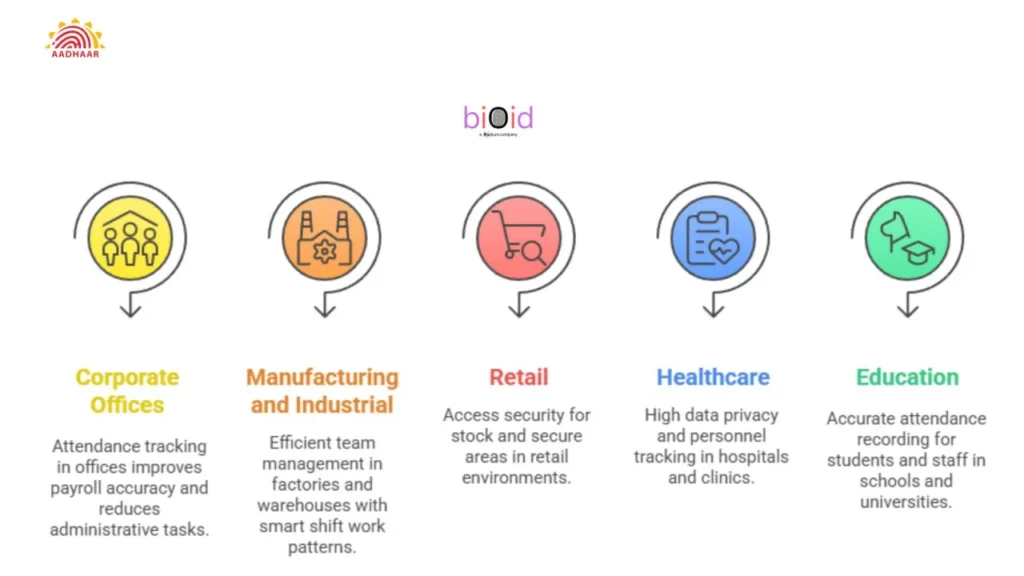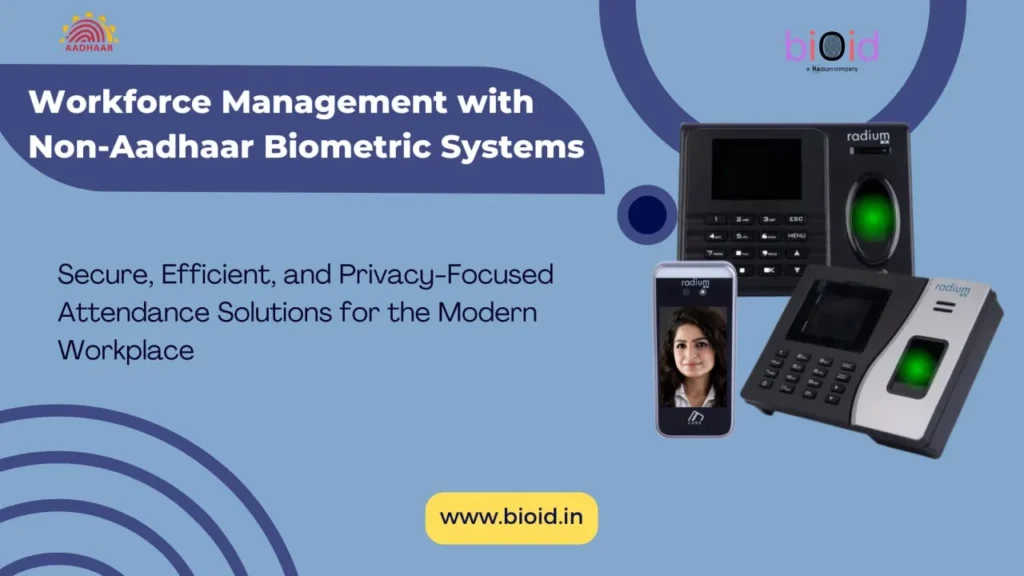Today, in a rapidly changing business environment, the pressure is increasing to customize its operations while maintaining strong security of organization employee data. Against this context, non-Aadhaar-based biometric appearance systems are becoming increasingly popular as an innovative option for traditional time-tracking techniques. Unlike Aadhaar -linked solutions, which are controversial to increase the issues of data privacy and dependence on the government, these independent biometric systems provide organizations with full control over their employee data. They provide compliance with privacy laws and offer speed, accuracy and scalability.
Fingerprints and face recognition systems such as non-aadhaar biometric solutions are best for businesses in search of efficient, safe and easy-to-use appearance management solutions. Bioid’s Thumbscan T1 and T2 and Facebox F1, F2, and F3 prove hardware such as how sophisticated biometric techniques can be adapted for various organizational settings.
This discusses how these systems are bringing revolution in the workforce management with the provisions of simple integration, real -time tracking and low administrative overhead. It also discusses the unique features of each device and how they play a role in increasing the presence accuracy, proxy entry cuts and operational efficiency in all industries.
Why Non-Aadhaar-Based Systems?
The evolution of non-Aadhaar biometric system arises from a number of factors that will realign the workforce again. Companies were experiencing entirely new sets of challenges with respect to the fundamental desire to secure data, the ongoing need to comply with an increasing array of privacy regulations, and the growing need to operating in a world that is turning operational efficiencies increasingly complicated. Non-Aadhaar-based systems address these demands by ending their biometric data, eliminating dependence on centralized government databases associated with Aadhaar-based systems.
The aadhaar-based biometric systems, while some applications are tightly integrated with an effective, government infrastructure, requiring specific rules and data-sharing protocols. This can be an obstacle for organizations that prefer data sovereignty or work in areas with strict privacy requirements such as healthcare, finance, or legal services. Additionally, concerns about data violations and unauthorized access to centralized databases have motivated businesses to find options that keep sensitive employee information at home.
Non-Aadhaar-based systems provide a compelling solution by storing biometric data locally with strong encryption, ensuring that organizations maintain ownership and control. This approach not only increases data privacy, but also provides more flexibility in deployment, allowing businesses to their unique operations and safety requirements. In addition, these systems support several authentication methods – such as fingerprints, facial identification, cards, or PIN -their workforce size, enabling organizations to customize solutions based on industry requirements or safety protocols.
Non-aadhaar-based systems lose their ability to give rapid and accurate appearance tracking, reduce administrative overheads and reduce errors such as “big punching” (where one employee gives watches to another). By basically integrating with existing HR and payroll systems, these solutions also reduce implementation costs and enable businesses to modernize the workforce management without overhauling their infrastructure. As a result, non-Aadhaar-based biometric systems are becoming an option for organizations seeking balance of safety, efficiency and adaptability in today’s fast-transportation scenario.
BioID: An Innovation-Driven
Bioid is a major Indian provider of advanced biometric attendance systems, which offers a full range of fingerprint and facial identity solutions to meet the developed needs of businesses in areas. By operating the aadhaar-based platforms independently, bioid prefer priority, accuracy, and autonomy, which fulfills the work of high-use. These solutions are designed for plug-and-play integration with HRMS, payroll and access control solutions, to meet the needs of various industries such as corporate, education, healthcare and manufacturing with local storage and offline capabilities.
Phil Technology Pvt. Limited is powered by a mission to empower Indian businesses with privacy-first technology, with focus on innovation and regulation. Its specialist team consistently combines product capabilities with innovative features, making them highly scalable and easy to apply. Easy tools of bioid serve outfits from small startups to large businesses, and are designed to complete India’s data security laws. With the increasing number of satisfied customers, bioid appearance is changing management and access control, and is at the forefront of traveling to India towards digital change.
Key Features of Biometric Devices
Devices such as those available from BioID do not have to be Aadhaar compliant and are designed to be high performance, have high scalability, and high reliability. The key specifications of Thumbscan T1, Thumbscan T2, Facebox F1, Facebox F2, and Facebox F3 are as follows, servicing businesses from small startups to large businesses.
Thumbscan T1
- Recognition Speed: It recognizes fingerprints in 0.25 seconds, suitable for high-traffic areas.
- Accuracy: 99.99% accuracy minimizes mistakes and protects against “buddy punching.”
- Storage Capacity: Stores 5000 fingerprints and 500,000 attendance records.
- Authentication: Combines fingerprints with card swiping or PIN codes.
- Use Case: Ideal for small to medium-sized companies such as offices or retail chains.
Thumbscan T2
- Recognition Speed: Quicker at 0.2 seconds, appropriate for high-turnover environments.
- Storage Capacity: Holds 10,000 fingerprints and 1,000,000 logs, great for larger companies.
- Connectivity: Equipped with Wi-Fi and internet for real-time synchronization across locations.
- Use Case: Suitable for industrial environments such as factories or warehouses.
Facebox F1
- Recognition Speed: Detects faces in 0.5 seconds. Best suited for small groups.
- Storage Capacity: Accommodates 1,000 facialscan , ideal for small installations.
- Design: Portable and easy to use, with easy-to-use touchscreen interface.
- Use Case: Suitable for small enterprises such as retail stores or clinics.
Facebox F2
- Identification speed: Fast at 0.3 seconds, 5,000 template storage.
- Features: Facial recognition, cards, and pin numbers, with cloud optional.
- Use Case: Mid-size organizations like schools or businesses/hospitals.
Facebox F3
- Recognition Speed: Lightning fast at 0.2 seconds, 10,000 storage of scans.
- Features: AI-based algorithms used and learning to variations of lighting and face, anti-spoofing.
- Use Case: High security institutions like hospitals or banking.
These machines blend nicely with HR, payroll and attendance software, and help save on the set-up costs. Ruggedness means less upkeep, and it lasts for the long term.
Applications Across Industries
Non-Aadhaar biometric devices are extremely flexible and able to target the very different needs of different sectors:

- Corporate Offices: Devices like Thumbscan T1 and Facebox F2 are able to accurately track attendance in office places around every department, giving an accurate payroll and requiring no administrative work.
- Manufacturing and Industrial: Devices like Thumbscan T2 and Facebox F3 are able to manage teams very efficiently in either factories or warehouses where smart shift work patterns make managing large workforces upwards of 100 employees simpler in more complicated and complex environments.
- Retail: Devices such as Facebox F1 and Thumbscan T1 provide access security to stock and secure ‘back of house’ areas, with Footprint and Facebox designed for smaller outlets with limited space.
- Healthcare: Devices such as Facebox F3 provide the highest levels of the privacy of data, protecting identity. Medical personnel in hospitals and clinics can be traced as required, according to strict compliance levels.
- Education: Devices such as Thumbscan T1 and Facebox F2 can record attendance (student/ staff) for schools and universities in order to eliminate inaccurate entries and provide protection against fraudulent entries.
Benefits of Non-Aadhaar-Based Systems
Data Autonomy
Today’s biometric solutions afford total control of sensitive data and provide effective local storage and robust encryption. All this independence means that organizations can keep biometrics like fingerprints or facial templates on their internal servers or on secure edge devices, which reduces external risk and offers private compliance with applicable legislation. The reduction of risk is not only about improved data protection, but it also creates trust with employees and stakeholders.
Cost Effective
Durability and seamless interoperability with other established biometric products, such as Thumbscan T2 and Facebox F3, inherently lowers the cost of obtaining and having biometric products. The products can be integrated directly into existing Access Control systems or existing HR management systems, without having to deal with such complex interactions. This means that while they might be operating with other biometric products at their current host location they are likely to see high utilization over a number of years.
Scalability
As organizations scale, the needs of workforce management and security management also increase. The sustainability of the products, the ability to accommodate thousands of users, and how easy they are to implement at any new location means that Facebox F3 and Thumbscan T2 were built for scalability at a mass level. Similar effective practices and processes can be effective at a small organization as well. Delivered value of central operations and data retention are overwhelming and will position organizations whether large or small to meet whatever challenge may arise in the future.
Conclusion
The thumbscan T1 and T2, and non-aadhar-based biometric appearance devices like Facebox F1, F2, and F3 offer a safe, skilled and flexible means to manage their workforce. These biometric devices are designed to function independently of the base authentication, which can lead to more control over how biometric data is captured, stored, and used. It provides easy compliance with freedom of data protection laws and low dependence on external databases.
With rapid accreditation rates and high-compatibility biometric matching, these systems also provide smooth appearance tracking in a heavy-trafficking environment. Ad-on features such as live detection, encrypted local storage, and multi-modal authentication options (fingerprint, face, card, pin) further promote security and purpose.
Their flexibility ensures that they can be applied to all types of businesses – from corporate headquarters to manufacturing plants to schools and health centers. Data, giving priority to privacy and scalable performance, strengthen the device organizations of bioid to adapt their operations by keeping full control over sensitive data.
FAQ’s
Que: What are non-Aadhaar-based biometric attendance systems?
Ans: Non-Aadhaar-based biometric attendance systems are standalone solutions that use biometric technologies to track employee attendance. Non-Aadhaar-based biometric attendance tracking systems present a solution to organizations that prioritize data privacy and wish to store biometric data locally on their devices, not for profit but to have full authority over their employees’ sensitive biometric information.
Que: Why use non-Aadhaar-based biometric attendance systems instead of Aadhaar-based?
Ans: Non-Aadhaar-based biometric attendance systems grant you more independence, as you do not have to rely on a centralized government-based biometric database. Non-Aadhaar systems comply with your local privacy laws, limiting the chance of public data breaches, and give you multiple options for authentication to suit the needs of your business (biometrics, fingerprint, facial recognition, card, PIN).
Que: How do Thumbscan and Facebox devices better manage the workforce?
Ans: BioID’s Thumbscan T1, T2, Facebox F1, F2, F3, can quickly recognize each employee in attendance 0.2-0.5 seconds and high accuracy when measuring attendance (up to 99.99% accuracy). In addition to the speed and accuracy, these devices seamlessly integrate with HR and payroll systems. These technologies help reduce errors (buddy punching), practicality (expedite attendance), and portability (grow with your business).
Que: Which industries can benefit from non-Aadhaar-based biometric attendance systems?
Ans: Non-Aadhaar-based biometric attendance systems are flexible and scalable, which benefit corporate offices, manufacturing, retail, healthcare, and education. For example, the Thumbscan T1 is a great option for small offices, whereas businesses at high-security environments, like a hospital or bank, can use the Facebox F3’s profile as a visitor/delivery authorization device.
Que: What measures do these systems take with regard to data privacy and security?
Ans: Non-Aadhaar-based systems work with biometric data recorded locally using strong security. The data is encrypted, and both the ownership and control rest with organizations. The external risk is limited, and compliance with protection legislations is assured. These systems are therefore usable in sensitive industries, including healthcare and finance.

